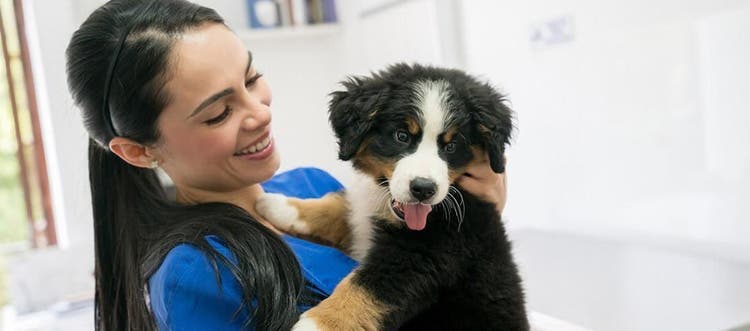Reviewed by Dr Sylvia Shortreed BVSc
Learn how to safely trim or file your dog’s nails with our step-by-step process.
The quick and easy guide to cutting your dog’s nails
Dogs’ nails need regular care, just like ours. Unless your dog spends a lot of time outside on hard or rough terrain (which will keep a dog’s nails trimmed naturally), you’ll have to cut them regularly.
How to trim your dog’s nails in four steps
Use our easy guide to get the job done quickly and safely.
1. Gather your supplies
Before you start trimming, make sure you have all the necessary supplies close at hand.
- A nail trimming or filing tool: The many gadgets available to trim your dog’s nails fall into one of three groups:
- Nail clippers: The most used tool for dog nail trimming, nail clippers are powerful tools that come in several styles with different features: plier style or scissor style, ergonomic or rubberised grip, quick-stop guard.
- Guillotine nail cutters: Guillotine nail cutters feature a single blade that slices off the end of the dog’s nail. They are easier to handle than nail clippers, but not as heavy duty. Guillotine nail cutters are generally better for smaller dogs with thinner nails as they tend to split thicker nails.
- Nail files: Nail files usually have a small rotating wheel that grinds or files down your dog’s nail tips. These devices make a noise that may frighten some dogs.
- Styptic powder: This powder is useful to have on hand if you accidentally cut the ‘quick’ of your dog’s nails while trimming them. Dip the affected nail into a small bowl of the powder or apply it directly to the bleeding nail using a cotton earbud. This causes a clot to form, stopping the bleeding.
- Treats: Have lots of your dog’s favourite treats on hand to help them through the process, especially the first few times you trim the nails to create a positive experience.
2. Hold one of your dog’s front paws in your hand
Start with the front paws. Hold your dog’s paw firmly but gently and identify where you want to make the cut.
Good to know: Once you begin clipping your dog’s back nails, lie the dog on their side. This will make it easier to access and hold their back paws.
3. Cut each nail, avoiding the quick
Make sure to cut off only the tip, the amount will depend on the length of your dog’s quick (which contains blood vessels and nerves) and how regularly the nails are trimmed.
Always cut from top to bottom and try to cut perpendicular to the nail. Avoid cutting the nail at an angle.
If your dog has white nails, you should be able to see the quick as a faint pink line. Cut no closer than 2mm from the quick.
If your dog has black nails, unfortunately the quick won’t be visible. However, as you cut your dog’s nails, look for a dark spot in the centre of the newly clipped edge – this is where the quick starts.
If you accidentally cut the quick, don’t panic. A dramatic reaction could signal to your dog that the situation is more serious than it is, which can then cause them to form a negative association with nail trimming. Instead, apply styptic powder to the affected nail until it stops bleeding, and give your dog a treat and some reassurance.
If you’re unsure about where to trim, it is always better to cut off too little than too much. You can always cut off a bit more later, if needed. If your dog has black nails, or you are unsure about cutting your dog’s nails, take them to a professional groomer or a vet who can do it for you.
Some dogs find nail trims very frightening and may need some extra help from the vet. Speak with your veterinarian about medical options like sedatives or relaxants, to make the process less traumatic for you and your dog.
4. Once you are done trimming, give your dog treats and cuddles
You’ll have to trim your dog’s nails on a regular basis, so make it a positive experience for your dog. When you are finished, give them treats and praise for behaving so well while you worked.
How often do I need to cut my dog’s nails?
Generally, a dog’s nails should be trimmed when they touch the ground. If you can hear your dog’s nails ‘click-clacking’ with every step, then their nails have grown too long and should be trimmed, however, this does also depend on the breed and conformation of the dog.
How quickly a dog’s nails reach this length will depend mainly on their environment and lifestyle. The nails of a dog that lives in a city and walks primarily on pavement will naturally stay shorter, as will the nails of dog exercising or working outside on hard or rough terrain. However, the nails of a dog with a leisurely indoor lifestyle or one that spends more time running on softer ground will be less worn.
How can I cut my dog’s nails without scaring them?
From an early age, get your dog into the habit of having their nails trimmed – they will be far more comfortable with the routine if you start when they’re young. Spend a few minutes each day getting your puppy used to having their paws touched. Rub around their paws and toes and reward them with their favourite treat as you do so. This will create positive reinforcement about having their paws and nails touched. Once your pup is comfortable with this, you can then introduce the nail clippers.
If you have an older dog, the process is the same but may take a bit longer. Be patient and use a soothing voice to reassure them.
When should I enlist help to cut my dog's nails?
If trimming your dog’s nails causes you anxiety or is simply a task you don’t like to take on, take your dog to a groomer or a vet who will trim their nails for a small fee.
If you have any concerns or think your dog’s nails are causing them pain or discomfort, get in touch with your local vet.









